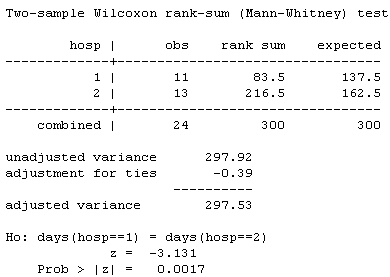 |
| BS1.12: Non-Parametric Statistics |
 |
| BS1.12: Non-Parametric Statistics |
OBJECTIVES |
| At the end of this section you should be able to understand the concept of non-parametric statistics. |
Non-parametric statistics are an alternative set of statistical tests for analysing numerical data that make no assumptions about the underlying distribution, for example the normality of the data. They are particularly useful when there is obvious non-normality in a data set, which cannot be corrected by a suitable transformation.
The Wilcoxon rank sum test is one of the non-parametric equivalents of the two-sample t-test for independent samples. It is used to test the null hypothesis that two populations have equal medians.
The Wilcoxon signed rank test is the non-parametric equivalent of the paired t-test. It involves the use of matched pairs, for example, before and after data, in which case it tests for a median difference of zero.
The following results, computed in Stata, shows a non-parametric analysis, comparing period of hospitalization in days between two hospitals.

The output shows a significant difference (P=0.0017) in period of hospitalisation between the two hospitals, 1 and 2.
 |
Interactive Examples **The Examples listed below have been included in order to illustrate the concepts discussed in this Section. |
|
| Question 1 | Question 6 | Question 11 |
| Question 2 | Question 7 | Question 12 |
| Question 3 | Question 8 | Question 13 |
| Question 4 | Question 9 | Question 14 |
| Question 5 | Question 10 |
**These examples work on Internet Explorer
